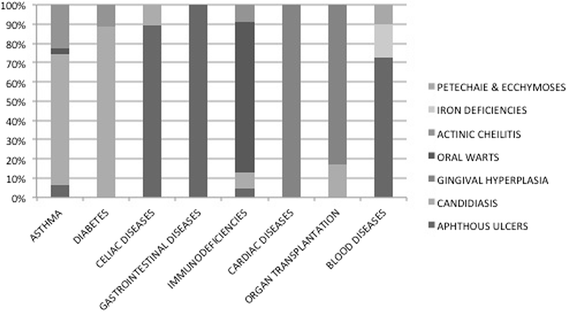Oral mucosal lesions in teenagers: a cross-sectional study
- PMID: 28569171
- PMCID: PMC5452358
- DOI: 10.1186/s13052-017-0367-7
Oral mucosal lesions in teenagers: a cross-sectional study
Abstract
Background: Adolescence is a period of transition to adulthood. Little is known about oral mucosal lesions (OMLs) in teenagers, in which the emergence of new habits, unfamiliar to children, could affect the type of lesions. The aim of this study was to evaluate the distribution of oral mucosal lesions (OMLs) in a wide sample of adolescents.
Methods: A retrospective cross-sectional study was carried out examining all medical records of adolescents (aged 13-18 years) treated at the Dental Clinic of the University of Brescia (Italy) in the period from 2008 to 2014. Cases with OMLs were selected. Data regarding age, gender, type of OML, bad habits, systemic chronic diseases were collected.
Results: A total of 6.374 medical records (mean age 15.2 + -1.7 years) were examined. We found 1544 cases (31.7%) of oral mucosal lesions; 36 different types of mucosal alterations were detected and the most frequent were: aphthous ulcers (18%), traumatic ulcerations (14.3%), herpes simplex virus (11%), geographic tongue (9.6%), candidiasis (5.5%), and morsicatio buccarum (4.7%). Papilloma virus lesions (1.7%), piercing-related lesions (4%), multiform erythema (0.13%), oral lichen planus (0.13%) and granular cell tumour (0.06%) were also diagnosed.
Conclusions: The prevalence of OMLs in adolescents are different from those in children and, in some conditions, it could increase with age.
Keywords: Adolescent; Epidemiology; Oral mucosal lesion.
Figures
References
-
- Rioboo Crespo MR, Planells del Pozo O, Rioboo Garcia R. Epidemiology of the most common oral diseases in children. Med Oral Patol Cir Bucal. 2005;10:376–387. - PubMed
MeSH terms
LinkOut - more resources
Full Text Sources
Other Literature Sources
Medical
Research Materials


